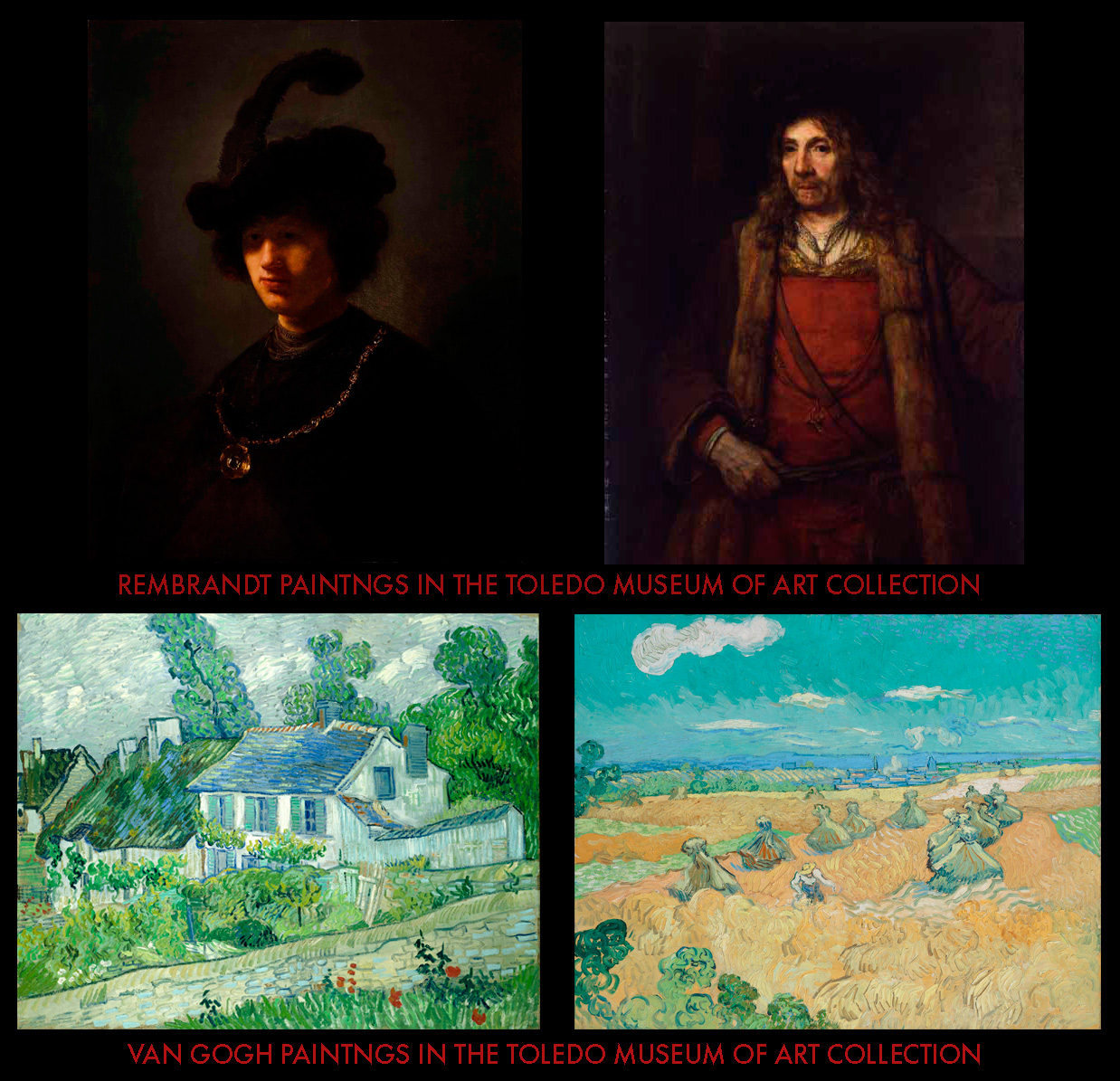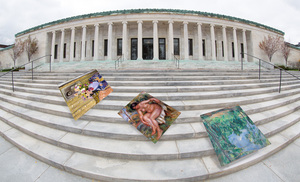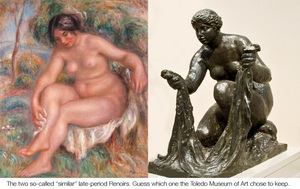
“The Toledo Museum of Art has never sought to have multiple examples by the same artist,” Adam Levine told museum supporters as to why the museum deaccessioned three paintings by Cézanne, Matisse and Renoir in April 2022. Above are two examples of what the Museum has two of: two Rembrandts and two Van Goghs.*
Questions about the deaccession of our Cézanne, Matisse, and Renoir paintings from the museum’s collection
To rationalize the deaccession of the paintings by Cézanne, Matisse and Renoir, Adam Levine told museum supporters that the paintings were inferior, and that the museum never sought to have more than one example of any given artist. He said that the Libbeys would want them to rid the museum of these paintings because they were mediocre, quoting Edward Drummond Libbey himself: “Let the multitudinous array of the mediocre be relegated to the past and in its place be found the highest quality, the best examples and the recognition of only those thoughts which will stand for all time.”
Those were lies. The paintings were not mediocre, and Libbey’s quote was taken out of context. The museum has always intended to have multiple examples of certain important artists. The Toledo Museum of Art is a teaching museum. These paintings were a big part of a small but strong collection of French Impressionist art, historically significant as marking the beginning of modern art, and the Toledo Museum of Art and the people of Toledo were so lucky to have them. Seems like it was for the money, and an eager buyer who wanted to buy our famous French Impressionist paintings from our collection, that made our museum officers want to sell them.
Many people objected to the deaccession, including Pulitzer Prize winning art critic Christopher Knight of the Los Angeles Times who wrote this May 6, 2022 article: COMMENTARY: AN OHIO MUSEUM IS HOLDING THE BIGGEST SALE OF ARTWORK YET. IT’S UNCONSCIONABLE.
The Blade wrote three articles prior to the sale, including an April 25, 2022 editorial written by the editorial board, TOLEDO MUSEUM OF ART SHOULD KEEP ITS TOP TIER.
I published on this website an Open Letter to the Toledo Museum of Art Trustees that I sent to board members by email.
The day before the sale, The Blade ran an article by Jason Webber, CONTROVERSY SURROUNDS TOLEDO MUSEUM OF ART SALE OF THREE PAINTINGS. In the article, the Toledo Museum of Art’s 2019-2020 interim director, John Stanley, who is retired now, spoke for the museum, saying he thought the deaccession was a “brilliant idea,” saying something to the effect of, what do those people who object to it know about art anyway, and “this is the world we live in.”
Then the night of the auction, we find out that the Cézanne and the Matisse were sold to the same buyer for a total of $57 million. What are the odds?
If that is not weird enough, to top it off, we discover John Stanley’s connection to a Las Vegas casino regarding French Impressionist paintings, and the owner of the casino, who collects them. John Stanley was COO of the Institute of Fine Arts, Boston when the museum rented 21 Monet paintings to the Bellagio. The owner of the casino, Steve Wynn is well-known as a collector of French Impressionist paintings. (This Vanity Fair article, Steve Wynn, the Uncrowned King of Las Vegas, mentions his masterpieces by van Gogh, Matisse, Picasso and Renoir.)
Meanwhile, Adam Levine is going overboard to make up for his 2020 George Floyd memo mistake, in which he published a memo he wrote to his staff advising that the museum was remaining neutral. Now, two years later, it seems he still can’t do enough to make up for it, but is the Toledo community being played, perhaps as a convenient distraction?
So we have to ask…
Who bought the paintings the museum deaccessioned last month? Did the buyer have any contact with anyone working at or associated with the museum before the decision was made to deaccession them or before they were sold?
What were the “market realities” that made Adam Levine “pull the trigger,” as described in Christopher Knight’s May 6, 2022 L.A. Times article, Commentary: An Ohio museum is holding the biggest sale of artwork yet. It’s unconscionable.?
Why is John Stanley on the “Art Committee,” when he is not a curator, and his educational background is in business and finance and not in art? Who else is on the “Art Committee?” Isn’t John Stanley retired, as reported in The Blade’s September 8, 2021 article about his 1.5 million gift to the museum? Is he a paid consultant, and if so, what for? Does he live in Toledo or New York, or somewhere else?

How did the museum decide to deaccession exactly those three paintings out of all the 30,000+ artworks that the museum has on display in our museum and in storage? Is selling artwork for the money an approved ethical reason to deaccession? How did all three deaccessions happen to be French Impressionist oil paintings exclusively? Was someone interested in the paintings before the museum put them up for sale?
Will the new museum officers be determining the one best painting of every artist that the museum has in its collection, and deaccession all others? Will it depend on outside interest of the possible sales of culled artworks? Will the museum curators be doing the same kind of collection culling with our collections of prints, drawings, photographs, books, sculptures, furniture, and ceramics?
 Why did they decide to keep the late period big bronze figure sculpture of Renoir’s, but get rid of the late period Renoir painting of the nude white woman? Because they were so similar, or was it for some other reason?
Why did they decide to keep the late period big bronze figure sculpture of Renoir’s, but get rid of the late period Renoir painting of the nude white woman? Because they were so similar, or was it for some other reason?
Will the new Robert and Sue Savage Community Gallery be curated by outside curators? Will it be for serious professional local artists, or will it be for neighborhood outreach projects? Will it only be for people who live in the two-mile outreach radius that the museum is concentrating on, as outlined according to the museum’s strategic plan, Program 3 listed under Objective 1? (Toledo Museum of Art Strategic Plan, /OBJECTIVE 1: Transition to Active Community Outreach and Engagement – “TMA will maintain a focus on the two-mile radius immediately around the Museum.” /Program 3: Engage Local Artists.)
The New York Philharmonic requires musicians to audition behind a curtain, so that the reviewers or judges don’t know the race or the sex of the performer; the musicians are chosen on their artistic merits. Can the museum share with us the results of the survey they made of the classifications and rating systems of the artwork in our collection? How do they determine the sexual orientation of the artist? Will they be requiring that information about local artists who want to show at the Robert and Sue Savage Community Gallery?
Are the new acquisitions going to be based on a quota system?
Will they be leveling up the museum’s collection of paintings to have an equal number of paintings by women artists, since the museum has been so male-centric, and if so, will the percentages match the population’s racial, poverty-level, and zip-code demographics of Toledo? Will they be buying, or selling, paintings to make it equitable?
According to Adam Levine in his April 8 letter to museum supporters, Important announcement from The Toledo Museum of Art, “We will use these proceeds to create a new acquisition endowment.” Does that mean they are creating a new acquisition endowment with the approximate $54 million they took from the paintings? For the two paintings that were originally purchased from the Edward Drummond Libbey Endowment, why isn’t the money being returned to the Edward Drummond Libbey Endowment until such time that it is used to by new art, as is required? Did they talk to the family of Mrs. C. Lockhart McKelvy about the deaccession of her gift of the Renoir?
When the director says that they are going to draw less from the Libbey Endowment, does he mean that they are going to sell two of its most valuable paintings and create a whole new endowment, free of any of the restraints or ties to the past?
On January 17, 2022 this year, why couldn’t the museum figure out how to celebrate its own 110th anniversary on the same day that you opened the museum on a Monday for MLK Day? If the leaders of the museum cannot feel comfortable honoring the museum’s own history while at the same time wanting to honor Black history, then shouldn’t we have better leaders? Shouldn’t the least we expect from Adam Levine or any director is that they show respect for The Toledo Museum of Art’s own history? And shouldn’t we also expect them at the very least to be good stewards of our best artwork and not to sell it off for the money, since it is a museum we are so lucky to have as Toledoans, and we want to keep our best artwork safe for future generations?
What percentage of the museum’s expenditures on new artwork in the past 10 years went to buy “diverse” artwork?
According to probate court records, the museum has been taking upwards of $500,000 out of the Libbey Endowments ($300,000 from Edward’s, and estimating that it is around $200,000 from Florence’s) over the past two years, granted for June 30, 2020 to June 30, 2022, on account of Covid, taking from the part of the endowment funds that are are meant to be used only to buy art. They filed and received a temporary variance on the Endowments’ rules, so they could use the money not to buy new art, but instead for expenses on “the direct care of art,” since the museum is somehow suffering financially. How is it that the museum is deserving of that variance to use the Endowments’ art acquisition money for expenses, when they have been hiring more employees, giving raises to employees, adding employee benefits, and sending employees off into the field to do things like to set up “art-making stations” in housing revitalization projects with developers? Why didn’t they want to buy diverse art with that money?
Considering that the museum didn’t use that variance money on art purchases as the museum expands “outside of its walls,” (indicating that the museum has plenty of money), but they got the money for “direct care” of the artwork in their collection, but instead of caring for the artwork, they sold the museum’s three great paintings out of a collection they are expected to care for, according to the fiduciary duty as the director and the officers of the museum, to set up a new endowment to buy new art, but why didn’t they buy new art with the $500,000 in the first place, without selling our three great paintings?
Don’t they care about how it appears that they could be buying museum board members’ votes, when there is a conflict of interest and ethical considerations regarding the museum doing business with board members? For example, buying insurance, accounting, managing investments, and other kinds of deals with various organizations, when the officers of the various organizations are directors on the board – how could the directors possibly vote no against any deaccession proposal, or anything that is recommended by the director, when financially, their businesses are so entangled with the museum? To be put in such a position, how are they are expected to be loyal to both interests at once, if one interest is the organization they work for, and the other interest is the public interest, say if they thought in their heart that the paintings should not be deaccessioned, but then they don’t want to rock the boat or interfere with the business relationships of their organizations doing business with the museum?
We should not tolerate the director and officers lying to us and selling our best art. They had a fiduciary duty first and foremost to care for these particularly important paintings that were a major part of our French Impressionist collection and our collection as a whole and keep them safe for future generations. That’s what museums do.
*Other artists of which there are two or more paintings in the Toledo Museum of Art collection include: Jean-Siméon Chardin (two bought at the same time in 2006 by esteemed curator emeritus Larry Nichols, a big deal was made by the museum about these two paintings being added to the collection), François Boucher, Thomas Couture, Charles Courtney Curran, Edgar Degas, Wilder M. Darling, Eugène Delacroix, Thornton Dial Jr., Gustave Doré, Thomas Doughty, Henri Fantin-Latour, Beverly Fishman, August Franzen, Gajin Fujita, Carl Frederick Gaertner, Luther Emerson van Gorder, Francesco Guardi, Childe Hassam, Martin Johnson Heade, Yoshida Hiroshi, Carl Robert Holty, Manuel Hughes, Roberto Humeres S., William Holman Hunt, Jozef Israëls, Karl N. Kahl, Gabriel Liston, Jacob Maris, Anton Mauve, Jean-Francois Millet, Joan Miró, Claude Monet, Edmund Henry Osthaus, Giovanni Paolo Panini, Camille Pissarro, Henry Ward Ranger, Pierre-Auguste Renoir, Niklaus Rüegg, Sebastiano Ricci, Sir Joshua Reynolds, Frank Stella, Yves Tanguy, Anne Vallayer-Coster, Élisabeth-Louise Vigée-Le Brun, Benjamin West, Alexander Helwig Wyant, Jacques Blanchard, Charles Loring Elliott, Thomas Gainsborough, Giovanni Paolo Panini, Gustave Courbet, Nicolas Poussin, Aert van der Neer, and Joos van Cleve. But now the museum only has one painting by Cézanne, and only one painting by Matisse, because they sold the other two for $57 million.

